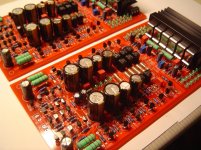Thank you Miib... As there is a 100r between the zener string and TP3 I was not shure 🙂
Now another noobness.... Why the need for 2 x 6800u on the input ?
What is the purpose of those caps ?
How low can I go if I decided to reduce this values ?
Now another noobness.... Why the need for 2 x 6800u on the input ?
What is the purpose of those caps ?
How low can I go if I decided to reduce this values ?
Maybe I hear some sarcasm in there? But I cleared (by the people of ATL) to help you identify the current 'best' circuit, it’s the attached one (circuit M in the file).
Hi Frans,
What is the purpose of IM resistor? Is it some simulation(parasitic) value to be neglected in real build?
Hi Frans,
What is the purpose of IM resistor? Is it some simulation(parasitic) value to be neglected in real build?
Just an easy place to measure cuttent (I used a 1 pico Ohm resistor)
A 1 pico Ohm resistor is innovative so Rams would aprove on that.
Ricardo, without those caps the circuit would have no bass.
Why that is : It forms a high pass filter with the forward impedance of the input stage
( sans the mirror that is ) and that is very low because we want low noise into low impedances. How the circuit works in detail ?
Apply for a PHD degree at Gerhard University.
Ricardo, without those caps the circuit would have no bass.
Why that is : It forms a high pass filter with the forward impedance of the input stage
( sans the mirror that is ) and that is very low because we want low noise into low impedances. How the circuit works in detail ?
Apply for a PHD degree at Gerhard University.
A 1 pico Ohm resistor is innovative so Rams would aprove on that.
Ricardo, without those caps the circuit would have no bass.
Why that is : It forms a high pass filter with the forward impedance of the input stage
( sans the mirror that is ) and that is very low because we want low noise into low impedances. How the circuit works in detail ?
Apply for a PHD degree at Gerhard University.
So those caps are responsible by the circuit bass response.... These are very important units.
Bass depends on those caps.... Now I am wondering about cap quality 🙂
I am working with available parts in my sock (4700u, 3300u and 2200u Pana FC).
As for the Gerhard PHD.... I want to but I must have to learn a lot before that... I am glad you are not like some that only share ideas with other PHD´s.
The issue is the cap size... only small caps will fit. I will experiment with what I have got and will tune after with bigger capacity caps.
Last edited:
2 x 4700uF FC will do just fine. They have approximately 5mOhm @ 100kHz in parallel so they are wide band enough. The FM have 40% less impedance, so what. In the bass both are ANIMALS. Charge them and discharge them. How long is the spark ?
Just an easy place to measure cuttent (I used a 1 pico Ohm resistor)
Thanks Frans!
Hesener, C5 should be 1uF printed on the PCB and not 100nF i think, i also can not find the 1MOhm resistor from output to servo.
noted, thanks
the 1M is upper righthand corner, between bc337 and 6.8nf caps
What is the big, single 15kOhm resistor in the middle of the PCB, left of the RIAA ?
thats R19, where michael said to let space for a bigger resistor due to higher power dissipation
Why ?
Most probably for thermal constraint, automotive design normally would be for -50C to +100C many (many many ...) cycles. Internal bounds, lead bounds and material tolerance could be at risk.
(that is where I come from 🙂)
(that is where I come from )
Well well, we can shake hands than buddy 🙂
Likewise here 😀 and agree fully with you.
Audiofanatic 😉
Well well, we can shake hands than buddy 🙂
Likewise here 😀 and agree fully with you.
Audiofanatic 😉
stuffing is finished ;-)
boards are full - power up planned for monday ;-)
this is with LCR caps, Dale resistors, and as good a matching as I could get. Input transistors are matched to 0.7% between all of them, the rest less... Its probably required to order 200...300pcs of each transistor type to get a perfect matching.....
boards are full - power up planned for monday ;-)
this is with LCR caps, Dale resistors, and as good a matching as I could get. Input transistors are matched to 0.7% between all of them, the rest less... Its probably required to order 200...300pcs of each transistor type to get a perfect matching.....
Attachments
Well well, we can shake hands than buddy 🙂
Likewise here 😀 and agree fully with you.
Audiofanatic 😉
Cool, and I can be a bit more specific on that. Once (a long time ago) I worked for Motorola, HP and International Rectifier (among others) as an industrial 'components in-design specialist', working with our customers helping with their designs (at the customer’s site) mostly do select components to fit them to their specific environment. I have done planes, trains and automobiles (among others, including the particle accelerator in Cern 🙂).

